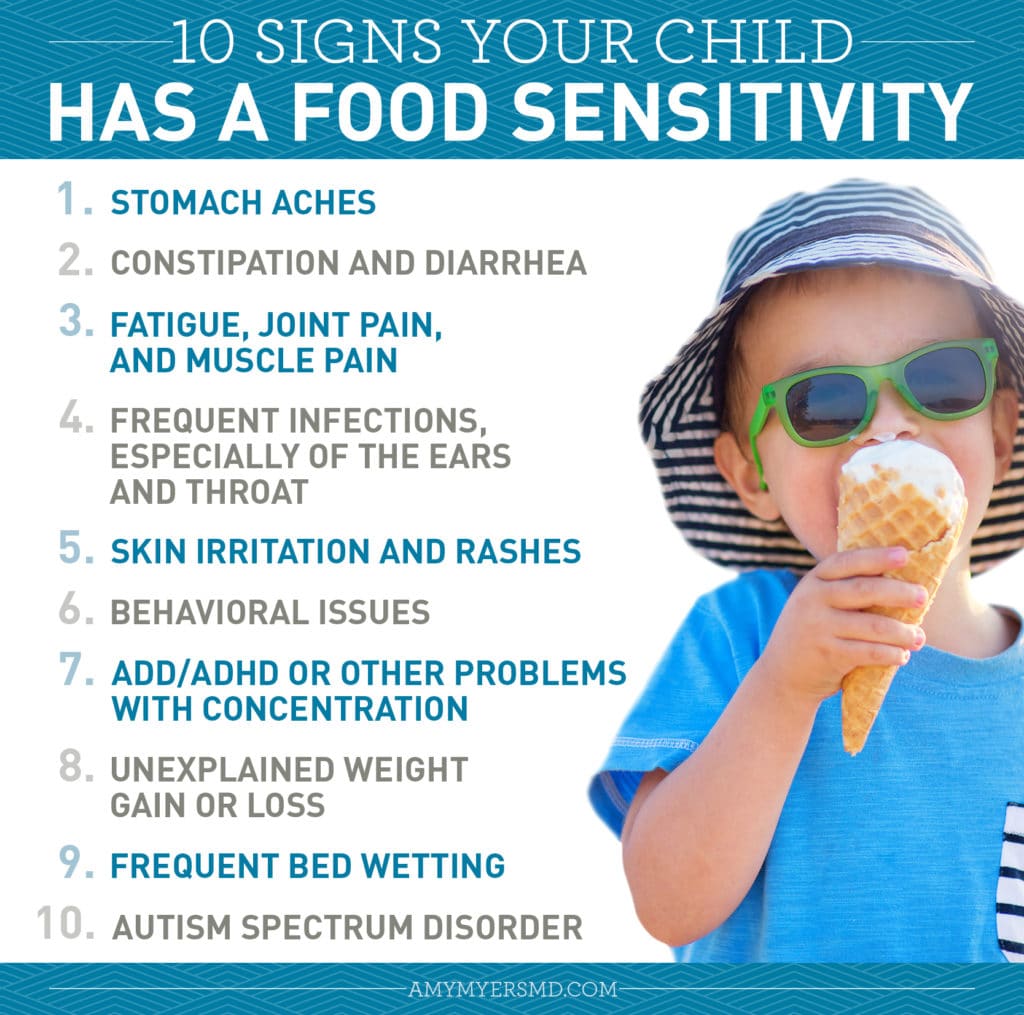If your child has a food allergy, you are probably already aware if, for example, he gets hives after he eats strawberries, or he can’t breathe around peanuts. Because of this immediate immune response or IgE reaction, food allergies are typically very easy to determine. Harder to pinpoint however are food sensitivities, which are IgG or delayed immune reactions. These IgG reactions can be very difficult to recognize because of the vague and often wide range of symptoms that may take up to 72 hours to display themselves.
Food sensitivities can develop over time, often because of overconsumption of these foods and imbalances in the gut microbiome. The top five food sensitivities I see in children are: gluten, dairy, corn, soy, and eggs. The potential consequences of consuming these foods if your child has a sensitivity to one of them are inflammation which can lead to a leaky gut and chronic illnesses such as autoimmune diseases in the future.
So what are the signs of food sensitivities in your child and how do you test for them?
 Dr. Amy Myers
May 26th, 2014
https://content.amymyersmd.com/article/child-food-sensitivity/10 Signs Your Child Has a Food Sensitivity – Infographic – Amy Myers MD®
Dr. Amy Myers
May 26th, 2014
https://content.amymyersmd.com/article/child-food-sensitivity/10 Signs Your Child Has a Food Sensitivity – Infographic – Amy Myers MD®10 Signs Your Child Has a Food Sensitivity
1. Stomach aches
2. Constipation and diarrhea
3. Fatigue, joint pain, and muscle pain
4. Frequent infections, especially of the ears and throat
5. Skin irritation and rashes
6. Behavioral issues
7. ADD/ADHD or other problems with concentration
8. Unexplained weight gain or loss
9. Frequent bedwetting
10. Autism Spectrum Disorder
How To Test For Food Sensitivities
I recommend that all of my patients, no matter what age, go through an elimination diet that I call The Myers Way®. On The Myers Way®, I have my patients remove a number of inflammatory foods from their diet for a few weeks and then gradually add each food back in one at a time, observing reactions and symptoms. Depending on the age of the child, severity of symptoms, and how picky they are, we may tailor the diet to include only the top five inflammatory foods listed above. I will often present The Myers Way® to the child as a science experiment where we are going to play detective and figure out which food causes which symptom or no symptom at all. Now remember, these IgG food sensitivity symptoms are often very vague and subtle!
For that reason, in my practice I frequently recommend doing an IgG food sensitivity blood test. The advantage of this is that we can see your child’s immune response to over 150 foods. The downside of this testing is that it’s not 100% perfect and there can be false positives if your child has a leaky gut and false negatives if they are not currently consuming the food.
At the end of the day, the body knows better than any test. If you remove the foods and your child feels better or symptoms resolve, that’s a sign of a food sensitivity. Or, if when your child adds the food back in he feels worse or his symptoms get worse, that’s a sign of a food sensitivity. My book, The Autoimmune Solution, guides you through the same 30-day elimination diet program I use in my clinic, with helpful meal plans and recipes.
5 Tips To Help You and Your Child Cope With Food Sensitivities
At first, this may seem overwhelming. Every parent wants their kid to be healthy and fit in. Luckily there’s plenty you can do to help them grow up healthy and happy. Regardless of age, the five tips below will help you ease their transition into a diet more suited for their bodies.
1. Empower your child.
This starts with the elimination diet. Allowing your child to be the detective and figure out which foods cause a problem gives them power over their health. I find that once children go through the elimination diet, they quickly recognize the correlation between the aggravating food and the uncomfortable symptoms. They make the decision themselves to avoid the food and don’t see it as an arbitrary rule they can break once they’re out of the house. Depending on how picky your child is, changes might be more difficult, but emphasize all of the delicious foods that your child CAN eat, instead of focusing on the few they can’t.
2. Eat what they eat.
Show your child that everyone else is on board with them, and that their sensitivity is not theirs alone. Food is intrinsically tied to our culture, our family, and our social life. That may be frustrating if you have a restricted diet, but it also presents you with a great opportunity to make new memories with your family: cooking together, finding new favorite restaurants, maybe even coming up with new snacks to take with you on trips. Your children look to you in every situation, so model for them. Show them how to prepare and cook for themselves. Demonstrate the importance of reading nutrition labels and asking questions at restaurants.
The stress of a diet change lessens when surrounded by a network of a supportive family. You shouldn’t expect your child to be able to give up a food they loved while the rest of the family eats it, and your family shouldn’t expect you to cook a different meal for each person. You do not want to create a dynamic where one child feels deprived. Support them by removing the food from your house. Chances are, the offending food isn’t so great for anyone else anyway. It’s best to remove problematic foods like gluten and dairy before illness has a chance to take root.
3. Ease the transition by getting creative in the kitchen.
This is a great opportunity to come up with some new recipes and get the entire family involved. Lay some guidelines and create a weekly menu with your children, giving them some say in what they eat. If your children are picky eaters, remember that tastebuds do eventually adapt and change, and the sooner changes are made the better.
You may be able to control what your children eat when they are at home, but what about when they are out of the house? This is where some preparation is truly essential. Pack a lunch for your child (if within your means) to sidestep problematic school lunches. Explain to them that they shouldn’t trade food with their classmates or eat the cafeteria food, and make that easier for them by packing fun snacks and lunches that they enjoy. Focus on whole fruits and vegetables, or other portable options like leftover soup in a thermos, nut butters, brown rice tortillas (if your child can tolerate grains), and maybe a homemade muffin as a treat.
4. Educate other parents and teachers.
Be your child’s advocate! If you cannot pack a lunch for your child, talk to the teachers about your options. Explain the situation to them and make sure they understand the seriousness of a food sensitivity, and which foods are problematic. Ask for a copy of the school lunch menu, and help your child select the appropriate meals.
Depending on the age of the child, classroom cross-contamination can be a concern. Ask your child’s teacher if you can give them some approved snacks to keep on hand in case a classmate brings food to share. Certain craft supplies contain gluten, so be sure to make your child’s teacher aware of that fact.
Outside of the classroom, educate other parents about the food sensitivity. If your child is going to a birthday party, ask if you can bring some yummy gluten-free treats for the party guests. Most people won’t be aware of the sensitivity, and as a parent you need to teach them.
5. Find a support system outside of your family.
There are many great resources for parents of children with dietary restrictions. It can be daunting helping your child cope with a food sensitivity while trying to navigate the changes yourself. Check out my list of extra resources, and join The Myers Way Community on Facebook–it’s a free group where you can share ideas with parents and children dealing with the same situation. Get started with some great gluten-free, dairy-free recipes from my blog, and visit my Facebook page!

